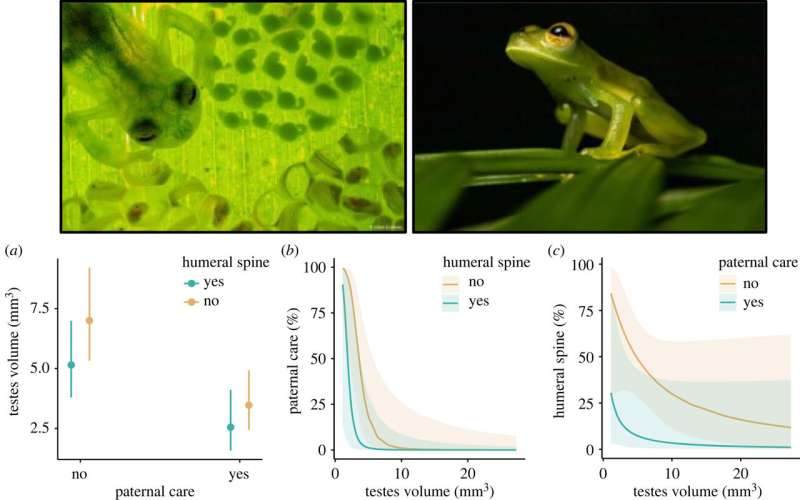February 23, 2024 report
This article has been reviewed according to Science X's editorial process and policies. Editors have highlighted the following attributes while ensuring the content's credibility:
fact-checked
peer-reviewed publication
trusted source
proofread
Male glass frogs that care for offspring found to have smaller testes

A small international team of animal behavior researchers has found that species of glass frogs whose males help care for offspring tend to have smaller testes than species whose males do not help care for offspring. In their study, published in the journal Proceedings of the Royal Society B, the group went into the tropical rain forests in Ecuador and Brazil to study the behavior of glass frogs over the course of several months.
Prior research has shown that in some species of glass frogs (so named because the skin on their belly is transparent), males help females care for and protect offspring. In this new study, the researchers wondered what biological differences might account for the different behaviors between species.
To find out, they ventured into the rainforest on multiple occasions to find and study as many glass frog species as they could locate from many sites. They were able to identify 37 unique species—of those, 11 represented species whose males helped care for the young.
In taking a closer look at any biological differences between those species with males that care for their young and those that do not, they found a difference in relative size of the testes. Those species whose males cared for offspring developed smaller testes.
The findings offer an example of a reproductive trade-off—in this case, between testes size and paternal care. They note that with glass frogs, the eggs laid by the female are not fertilized until they have been laid. That makes them fair game for any male who happens to pass by.
Species whose males help to care for the young are demonstrating two behaviors to ensure that their genes are the ones that are passed on. First, by getting to the eggs before other males and fertilizing them, the male ensures this his genes are in play. Second, by helping to take care of the eggs, he helps to make sure that they have a better chance of hatching, growing and reproducing on their own.
More information: Anyelet Valencia-Aguilar et al, Evolutionary trade-offs between testes size and parenting in Neotropical glassfrogs, Proceedings of the Royal Society B: Biological Sciences (2024). DOI: 10.1098/rspb.2024.0054
Journal information: Proceedings of the Royal Society B
© 2024 Science X Network




















